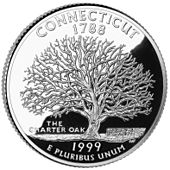
The Alabama Centennial half dollar, or Alabama half dollar, was a commemorative fifty-cent coin struck by the United States Bureau of the Mint in 1921 as a belated acknowledgement of the 100th anniversary of Alabama's admission to the Union in 1819. The coin was created by Laura Gardin Fraser, the first woman credited with designing a coin.

The Bridgeport, Connecticut, Centennial half dollar is a commemorative fifty-cent piece issued in 1936 by the United States Bureau of the Mint to honor the 100th anniversary of the incorporation of Bridgeport, Connecticut, as a city. Designed by Henry Kreis, the obverse depicts the showman P. T. Barnum, who was one of Bridgeport's most famous residents, was mayor of the city, helped develop it, and is buried there. The reverse depicts a stylized eagle.

The Elgin, Illinois, Centennial half dollar was a fifty-cent commemorative coin issued by the United States Bureau of the Mint in 1936, part of the wave of commemoratives authorized by Congress and struck that year. Intended to commemorate the centennial of the founding of Elgin, the piece was designed by local sculptor Trygve Rovelstad. The obverse depicts an idealized head of a pioneer man. The reverse shows a grouping of pioneers, and is based upon a sculptural group that Rovelstad hoped to build as a memorial to those who settled Illinois, but which was not erected in his lifetime.

The California Diamond Jubilee half dollar was a United States commemorative silver fifty-cent piece struck at the San Francisco Mint in 1925. It was issued to celebrate the 75th anniversary of California statehood.

The United States Sesquicentennial coin issue consisted of a commemorative half dollar and quarter eagle struck in 1926 at the Philadelphia Mint for the 150th anniversary of American independence. The obverse of the half dollar features portraits of the first president, George Washington, and the president in 1926, Calvin Coolidge, making it the only American coin to depict a president in his lifetime.
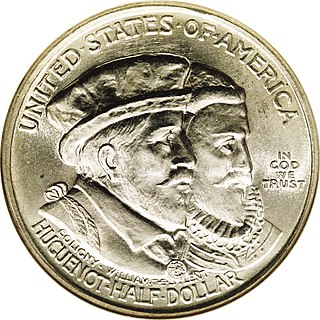
The Huguenot-Walloon half dollar or Huguenot-Walloon Tercentenary half dollar is a commemorative coin issued by the United States Bureau of the Mint in 1924. It marks the 300th anniversary of the voyage of the Nieuw Nederlandt which landed in the New York area in 1624. Many of the passengers were Huguenots from France or Walloons from what is now Belgium; they became early settlers of New York State and the surrounding area.

The Pilgrim Tercentenary half dollar or Pilgrim half dollar was a commemorative fifty-cent coin struck by the United States Bureau of the Mint in 1920 and 1921 to mark the 300th anniversary (tercentenary) of the arrival of the Pilgrims in North America. It was designed by Cyrus E. Dallin.

The Maine Centennial half dollar is a commemorative coin struck in 1920 by the United States Bureau of the Mint, in honor of the anniversary of Maine's admission to the Union on March 15, 1820. It was sculpted by Anthony de Francisci, following sketches by artist Harry Cochrane, from Monmouth, Maine.

The Maryland Tercentenary half dollar was a commemorative fifty-cent piece issued by the United States Bureau of the Mint in 1934. It depicts Cecil Calvert, 2nd Baron Baltimore on the obverse and the Coat of Arms of Maryland on the reverse.

The Hudson, New York, Sesquicentennial half dollar, sometimes called the Hudson Sesquicentennial half dollar, is a commemorative fifty-cent piece struck by the United States Bureau of the Mint in 1935. The coin was designed by Chester Beach. Its obverse depicts the Half Moon, flagship of Henry Hudson, after whom the city of Hudson, New York is named. In addition to showing the ship, the coin displays a version of the Hudson city seal, with Neptune riding a whale, a design that has drawn commentary over the years.
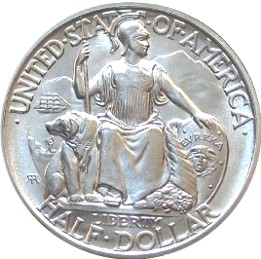
The California Pacific International Exposition half dollar, sometimes called the California Pacific half dollar or the San Diego half dollar, is a commemorative fifty-cent piece struck by the United States Bureau of the Mint in 1935 and 1936. Robert Ingersoll Aitken designed the coin. Its obverse depicts Minerva and other elements of the Seal of California; the reverse shows buildings from the California Pacific International Exposition, which the coin was issued to honor.

The Old Spanish Trail half dollar is a commemorative coin struck by the United States Bureau of the Mint in 1935. The coin was designed by L. W. Hoffecker, a coin dealer, who also was in charge of its distribution.
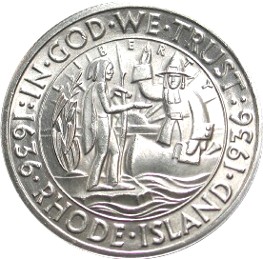
The Rhode Island Tercentenary half dollar is a commemorative fifty-cent piece struck by the United States Bureau of the Mint in 1936. The coin was designed by John Howard Benson and Arthur Graham Carey. Its obverse depicts Roger Williams, founder of the Colony of Rhode Island and Providence Plantations. It was intended to honor the 300th anniversary of Providence, Rhode Island, although it bears no mention of the city.

The Long Island Tercentenary half dollar was a commemorative half dollar struck by the United States Bureau of the Mint in 1936. The obverse depicts a male Dutch settler and an Algonquian tribesman, and the reverse shows a Dutch sailing ship. It was designed by Howard Weinman, the son of Mercury dime designer Adolph A. Weinman.

The York County, Maine, Tercentenary half dollar is a 50-cent commemorative coin minted in 1936 to mark the tercentenary of the founding of York County, Maine. The obverse shows Brown's Garrison, the fort around which York County was formed, while the reverse depicts the county's arms.

The Lynchburg Sesquicentennial half dollar was a commemorative half dollar designed by Charles Keck and struck by the United States Bureau of the Mint in 1936, to celebrate the 150th anniversary of the 1786 incorporation of the independent city of Lynchburg, Virginia. The obverse of the coin depicts former Secretary of the Treasury and U.S. Senator Carter Glass, a native of Lynchburg. The reverse depicts a statue of the Goddess of Liberty, with Lynchburg sites behind her, including the Old Courthouse and the city's Confederate monument.

The Columbia, South Carolina, Sesquicentennial half dollar was a commemorative fifty-cent piece struck by the United States Bureau of the Mint. Designed by Abraham Wolfe Davidson and minted in 1936, it marks the 150th anniversary of the designation of Columbia as South Carolina's state capital.

The Delaware Tercentenary half dollar is a commemorative fifty-cent piece struck by the United States Bureau of the Mint to commemorate the 300th anniversary of the first successful European settlement in Delaware. The reverse features the Swedish ship Kalmar Nyckel, which brought early settlers to Delaware, and the obverse depicts Old Swedes Church, which has been described as being the oldest Protestant church in the United States still used as a place of worship. While the coins are dated "1936" on the obverse and the reverse also has the dual date of "1638" and "1938", the coins were actually struck in 1937.

The Albany Charter half dollar, also known as the Albany-Dongan half dollar or Albany half dollar, is a commemorative half dollar struck by the United States Bureau of the Mint in 1936. It was designed by sculptor Gertrude K. Lathrop, who lived in Albany, New York's state capital.
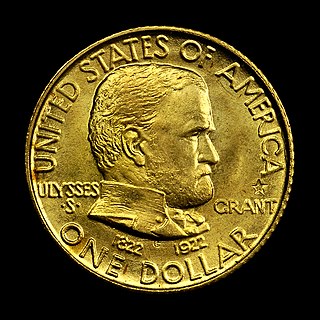
The Grant Memorial coinage are a gold dollar and silver half dollar struck by the United States Bureau of the Mint in 1922 in honor of the 100th anniversary of the birth of Ulysses S. Grant, a leading Union general during the American Civil War and later the 18th president of the United States. The two coins, identical in design and sculpted by Laura Gardin Fraser, portrayed Grant on the obverse and his birthplace in Ohio on the reverse.


